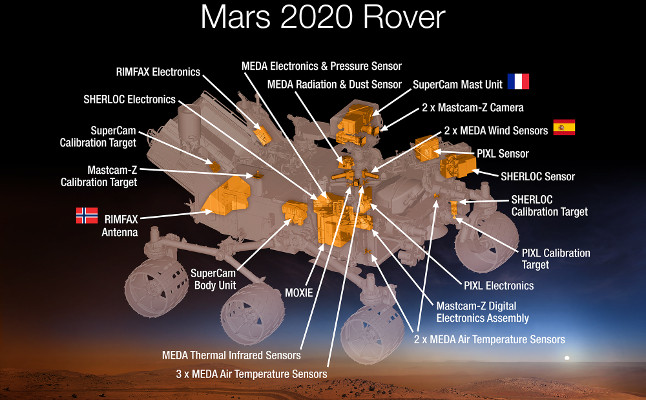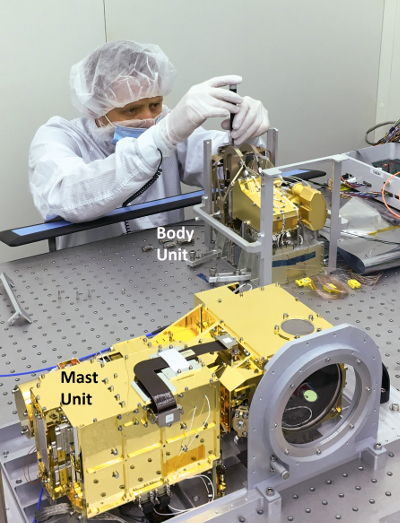Cathy Quantin-Nataf, Gilles Dromart and Gilles Montagnac of the Laboratoire de Géologie de Lyon (LGL-TPE) are members of a research team developing one of the instruments that will go aboard the rover of the Mars 2020 Mission: the SuperCam.
Watch live as NASA's next rover, Mars 2020, is built and tested in the Spacecraft Assembly Facility at the agency's Jet Propulsion Laboratory in Pasadena, California. © NASA/JPL-CalTech - June 2019
Mars 2020
 Mars 2020 is a mission to explore the planet Mars using a rover robot developed by NASA's Jet Propulsion Laboratory (JPL), which is scheduled to be launched in Cape Canaveral, Florida in the summer of 2020.
Mars 2020 is a mission to explore the planet Mars using a rover robot developed by NASA's Jet Propulsion Laboratory (JPL), which is scheduled to be launched in Cape Canaveral, Florida in the summer of 2020.
This project started in 2013 and the following year, the instruments that will be part of the payload of the rover, including the SuperCam, were selected.
SuperCam
SuperCam is a set of several instruments that will enable scientists to study geology remotely.
Using a high-resolution color camera, a laser and spectrometers, it can identify the chemical and mineral composition of rocks and soil and also detect organic compounds, on surfaces as small as a pencil tip, at a distance of between 7 and 12 meters.

It will help researchers understand the geological context – based on their knowledge of geology and life on Earth – enabling them to identify environments conducive to a past or present life on planet Mars.
SuperCam is also a tactical instrument that will be used to position the rover with small movements (bumps) to carry out contact analyses that require real proximity (using the rover's arm for example). It will also be very useful to select samples that future missions will bring back to Earth.
The instrument is divided into two units. The first, on the rover (body unit), features the spectrometers. The second, on the mast of the rover (mast unit), includes the laser and the telescope. The flight models of these two units will soon be integrated into the rover within the JPL.
SuperCam has been developed by three laboratories: Los Alamos National Laboratory (LANL, Los Alamos, États-Unis), Institut de recherche en astrophysique et planétologie (IRAP, Toulouse) and Laboratoire d'études spatiales et d'instrumentation en astrophysique (LESIA, Paris).
Researchers at Laboratoire de Géologie de Lyon have joined the scientific team of SuperCam to add their expertise to the project. The rover should land in February 2021, followed by an operation phase during which this international scientific team (with members from the USA, France, Spain and Denmark) along with engineers from the CNES and JPL who will have to fly the robot for nearly two and a half years.






